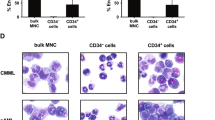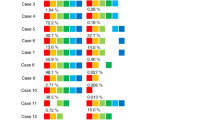Abstract
Pancytopenia is a frequent manifestation of myelodysplastic syndromes (MDS). In the presence of an empty bone marrow, clinical distinction from aplastic anemia may be difficult. The hypoplastic marrow morphology seen in some cases of MDS raises questions about etiologic and pathophysiologic relationships between aplastic anemia and MDS. The goal of our study was to compare the degree of the hematopoietic failure in these diseases at the level of the most immature progenitor and stem cells that can be measured in vitro. In a systemic, prospective fashion, we have studied bone marrow (n = 45) and peripheral blood (n = 33) of patients with MDS for the number of long-term culture initiating cells (LTC-IC) in comparison to 17 normal controls and patients with new, untreated aplastic anemia (46 marrow; 62 blood samples). Due to the low numbers of cells available for the analysis, formal limiting dilution analysis could not be performed, instead secondary colony-forming cells (CFC) after 5 weeks of LTBMC were measured. As the number of these cells is proportional to the input number of LTC-IC, the number of secondary CFC per 106 mononuclear cells (MNC) initiating the LTBMC can be used as a measure of the content of immature stem cells in bone marrow and peripheral blood. The MDS group consisted of 34 RA, three RARS, eight RAEB and two RAEB-T patients with mean absolute neutrophil values of 1992, 1413, 1441, and 380 per mm3, respectively. The diagnosis was established based on bone marrow morphology and results of cytogenetic studies. In comparison to controls (147 ± 38/106 MNC), significantly decreased numbers of bone marrow secondary CFC were found in MDS: in patients with RA and RARS, 21 ± 7 secondary CFC per 106 bone marrow MNC (P < 0.001); patients with raeb and raeb-t: 39 ± 12 cfc per 106 marrow MNC (P < 0.001). in all groups tested, the decrease in peripheral blood secondary cfc numbers was consistently less pronounced. in mds patients with hypocellular bone marrow, secondary cfc were lower but not significantly different in comparison to mds with hypercellular marrow (18 ± 6 vs 35 ± 11; NS; hypoplastic bone marrow also was not associated with significantly lower neutrophil counts). However, in 24% of patients with MDS, bone marrow secondary CFC were within the normal range, while in the aplastic anemia group only one of the patients showed secondary CFC number within normal range. Bone marrow and blood secondary CFC numbers in hypoplastic RA were significantly higher than those in severe aplastic anemia 919 ± 5 in bone marrow, P < 0.01; 7 ± 2 in blood, P < 0.05). this trend was even more pronounced in hypoplastic ra with chromosomal abnormalities. however, no significant differences were found between the secondary cfc numbers in hypoplastic ra and moderate aplastic anemia. we concluded that, although the deficiency in the stem cell compartment is less severe in mds than in aplastic anemia, depletion of early hematopoietic cells is an essential part of the pathophysiology in both diseases.
This is a preview of subscription content, access via your institution
Access options
Subscribe to this journal
Receive 12 print issues and online access
$259.00 per year
only $21.58 per issue
Buy this article
- Purchase on Springer Link
- Instant access to full article PDF
Prices may be subject to local taxes which are calculated during checkout
Similar content being viewed by others
Author information
Authors and Affiliations
Rights and permissions
About this article
Cite this article
Sato, T., Kim, S., Selleri, C. et al. Measurement of secondary colony formation after 5 weeks in long-term cultures in patients with myelodysplastic syndrome. Leukemia 12, 1187–1194 (1998). https://doi.org/10.1038/sj.leu.2401084
Received:
Accepted:
Published:
Issue Date:
DOI: https://doi.org/10.1038/sj.leu.2401084
Keywords
This article is cited by
-
Insufficiency of FZR1 disturbs HSC quiescence by inhibiting ubiquitin-dependent degradation of RUNX1 in aplastic anemia
Leukemia (2022)
-
Clonality of the stem cell compartment during evolution of myelodysplastic syndromes and other bone marrow failure syndromes
Leukemia (2007)
-
Myelodysplastic syndromes: the complexity of stem-cell diseases
Nature Reviews Cancer (2007)
-
Cobblestone area measuring (CAM) assay: a new way of assessing the potential of human haemopoietic stem cells
Methods in Cell Science (2004)



